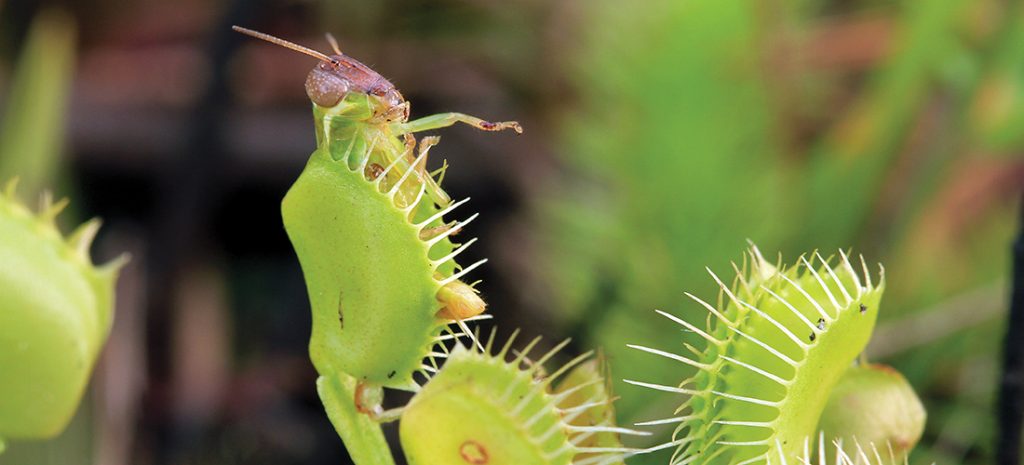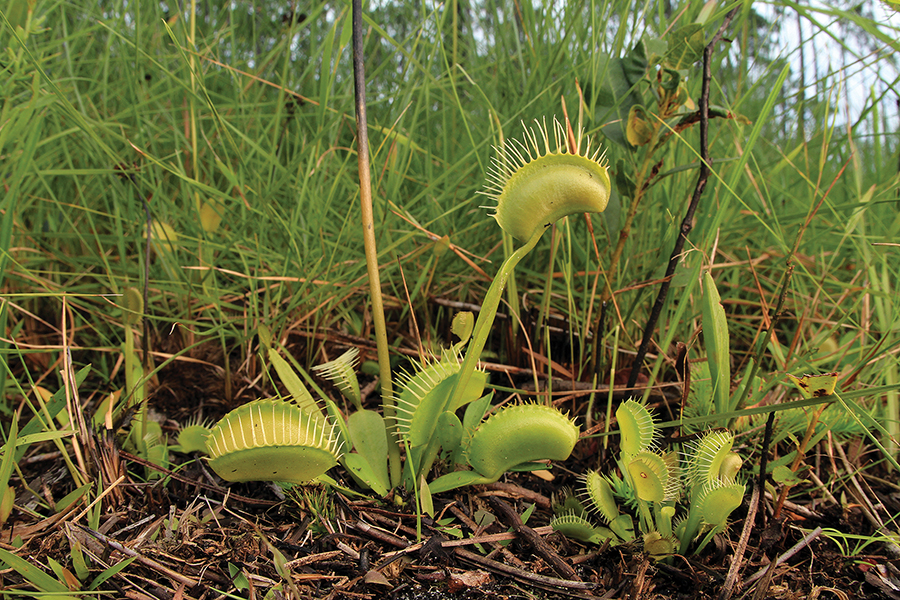The Naturalist

A Most Wonderful Plant
Unique to the Carolina wilds, the Venus flytrap is a botanical marvel
Story and Photographs by Todd Pusser

The year was 1860, and an industrious biologist was busy conducting experiments on a strange carnivorous plant in his backyard greenhouse in Downe, England. Plants that trapped and fed on other living organisms flamed the imaginations of 18th century biologists and the general public alike. Having traveled the world and written about many of its natural wonders, the biologist had recently become enthralled with a carnivorous sundew that grew in a forest near his home. He questioned how such a plant came to rely on the tissues of insects captured within its sticky tentacles for sustenance.
What began as a simple scientific hypothesis quickly blossomed into an obsession. When a friend, Dr. Joseph Hooker, director of the world-famous Kew Gardens, provided him with another botanical bestiary for study, his obsession became all-consuming.
The plant in question had been discovered 100 years before in the piney woods near Wilmington, North Carolina. The Colonial governor of the Tarheel state at that time, Arthur Dobbs, penned its first description in 1759 and marveled how the “great wonder of the vegetable world” possessed the ability to catch a fly between its modified leaves, like a spring trap. Several years later, that vegetable wonder became known as the Venus flytrap.
And the biologist who was working diligently trying to understand the mechanics of the flytrap’s carnivorous behavior in that backyard greenhouse? His name was Charles Darwin.
Lying flat on my belly, beneath towering pines and the brilliant blue sky of a humid August afternoon, I couldn’t help but think of Darwin as I closely examined a small grasshopper struggling within the vise-like grip of a large flytrap. With each twitch of the leg, the flytrap pressed its toothy green leaves more tightly around the struggling insect.
The ambient air temperature was somewhere north of ridiculous. Wiping sweat from my brow, I intently focused my camera lens on the miniature drama unfolding down on the forest floor. Grasshoppers had been particularly abundant that day, with hundreds of young nymphs hopping about my feet as I carefully walked across a Brunswick County pine savannah, searching for orchids to photograph. Flytraps had not been on my radar, but when I noticed the botanical carnivory playing out beneath a golden clump of wiregrass, I couldn’t resist snapping a few frames.
The young grasshopper finally stopped struggling, seemingly resigned to its fate. Magnified many times larger by the optics of my macro lens, the fanged snarl that clamped tightly around the doomed insect instantly reminded me of Audrey, the sentient man-eating plant from 1986’s musical/horror/comedy Little Shop of Horrors, a movie whose lead character design was inspired by the very plant I was currently photographing. It would take days for the flytrap to produce enough enzymes to fully digest this large meal.
It was likely Charles Darwin’s father, Erasmus, who planted the seed, so to speak, for his son’s obsession with carnivorous plants. The elder Darwin had examined, firsthand, the workings of Venus flytraps, not long after the species had been described. Writing in a 1789 poem titled The Botanic Garden, he described how the plant’s leaves possessed “a wonderful contrivance to prevent depredations of insects,” later elaborating “that when an insect creeps upon them, they fold up, and crush or pierce it to death.”
Decades later, his son would place small pieces of meat and drops of sugar water on a flytrap and eventually discover that it took a stimulation of two hair-like structures, nestled on the interior lobes of its leaves, within 20 seconds of each other, to trigger the closing of the trap.
Growing in acidic, nutrient-poor soils where other plants struggle to survive, Venus flytraps are found only within a 100-mile radius of Wilmington, North Carolina, and nowhere else on the planet. The reasons for this extreme limited distribution are not known. What is more certain is the fact that these charismatic perennials are becoming more and more rare across the landscape. In North Carolina, Venus flytraps once grew naturally in 20 counties. Today, they are found in just 12. The primary reason for their decline is habitat loss. That portion of the state is rapidly being converted into housing developments, fast-food restaurants and strip malls. Despite carrying a felony offense, poaching also contributes to the flytrap’s demise.
Nevertheless, where populations of the plant persist, their numbers can be surprisingly high. Years back, I had the unique opportunity to visit one such spot deep in the heart of Fort Bragg. Accompanied by a group of biologists and munitions specialists with the United States Army, I was able to examine a sloping hillside literally carpeted with hundreds upon hundreds of flytraps. The plants thrived there due in large part to the persistent fires caused by the frequent bombing of the land by the military.
In 1875, Charles Darwin published his decades-long research on the Venus flytrap and other carnivorous plants in a book titled Insectivorous Plants. Though the volume did not shake the foundations of scientific thought the way his earlier book The Origin of the Species had, it did serve as a template for future studies on carnivorous plants. In the chapter describing the flytrap, the normally reserved biologist and progenitor of the scientific theory survival of the fittest declared the plant “one of the most wonderful in the world.”
Back in the Brunswick County pine forest, I get up off the ground with camera in hand. Flipping through the images on the LCD, I pause at a close-up of a green toothy maw wrapped around the body of the tiny grasshopper and am instantly filled with childlike wonder of this botanical carnivore. I smile and shake my head, trying in vain to process how such a plant evolved. A Venus flytrap is indeed the most wonderful plant in the world. PS
Naturalist and photographer Todd Pusser grew up in Eagle Springs. He works to document the extraordinary diversity of life both near and far. His images can be found at www.ToddPusser.com.
